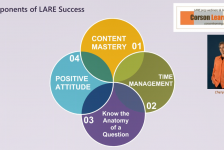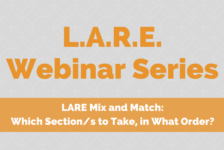As anyone who has sat for the LARE exam knows, at the top of the screen of every question is a tab that says, “Comments.” The first time I saw this, during the exam, I was intrigued. After all, CLARB’s LARE intro videos show examples of the exam interface, which show only the screen tab called, “Exhibits” for graphic questions on Sections 3 and 4. No mention is made anywhere about a tab called “Comments,” including during the tutorial given in the exam room prior to launching the LARE. “Would CLARB offer words of encouragement in this Comments tab?”, I wondered during the first few minutes of my exam.
After the adrenaline rush of the exam’s first few minutes wore off, I did click on one of the Comments tabs, only to discover a blank window in which to type. Who will read this, I wondered? Is this a good thing or not? Why has no mention been made of this before?
My Comment Story
Having ignored the Comments tab throughout most of my Section 4 exam, I became tempted to use it while trying to solve one particularly vexing drag and drop question. I had become convinced that the correct response simply did not appear on the left side of the screen among the possible choices. It was well into the four hour exam and I was getting fatigued.
My internal dialog went like this: “There’s got to be a mistake with this question. There should be more of these responses on the left side of the screen than there are. I bet that CLARB reads these Comments, and I’m going to complain.” I opened the Comments tab and began to type.
As soon as I began, a light went off in my head and I realized that there was nothing wrong with the question. I had just misinterpreted it. Indeed, there was only one correct drag and drop response on the left side of the screen. Had I persisted in my Comments tab rant I surely would have missed it. This experience convinced me to avoid the Comments tab thereafter.
The Exam’s Fourth Wall
In theater, the fourth wall is an imaginary boundary separating the audience and the actors on stage. The Greek chorus in a play is one example of breaking the fourth wall. The LARE Comments tab is a dangerous vehicle because it encourages the test taker to break that fourth wall between their role as test taker, to become a commentator instead. This can break one’s concentration and undermine one’s self-confidence by introducing negative self-talk into the exam experience. It is also a time-eater. I can’t imagine a situation in which a test taker would write a comment complimenting CLARB on having written a particularly good question.
Sometimes there might be reason to comment. I would limit this to extreme examples. I know some test takers a couple of years ago whose exams contained a few questions in which there were no spaces between any words on a multiple response question. This would be a good reason to comment, but keep it brief. Perhaps insert a little humor by writing, “therearenospacesbetweenanywordsonthisquestion.” I have not heard of this happening again, and I suspect that CLARB threw out those particular questions.
What CLARB Does
Some people believe that if they comment during the exam, explaining to CLARB why they answered the way they did, that it may improve their score. This is unlikely. According to Jim Penrod, former CLARB deputy director, during a presentation he gave to the ASLA LARE Prep Sub-Committee when I served on it, CLARB engages a statistician who flags questions whose answers differed to a statistically significant degree from that which was expected. Then, the volunteer committee who writes the exam questions must make a determination – either stay the course on what they felt the correct response would be, accept the alternate responses in addition to the expected response, or throw the question out. No one is going through one person’s comment and making a determination about whether or not to grant that one person that one question.
Keep in mind that everyone’s exams differ slightly, either in exact content, or at least in the order of the questions. Rebecca Moden of CLARB suggested that if a particular question is troubling you, wait until after the exam and email CLARB within a week. You do not need to remember the exact question number, since the question order varies. You only need to remember the content, and not precisely either. Writing CLARB cannot hurt your score and it may or may not help, based on the aggregate response of all test takers to that exam item.
Keep your self-talk during the exam as positive as possible. Avoiding the Comments tab is one way to help maintain your focus and confidence during this rigorous experience.





